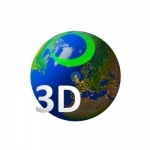Aurora Forecast 3D
AppThis item doesn’t have any media yet
Weather | Education
iOS
The Aurora Forecast 3D is a tool to track down where the aurora is located in the sky from any location on planet. It renders Earth in 3D with rotation and scaling at your fingertips. You can select locations and make your own ground - station list. The Sun illuminates the globe as it updates in near real-time (1 second epochs). The forecasts are +0, +1 and +4 hours ahead in time. These are updated every 15 minutes when the app is active and connected to internet.
An Aurora Compass is included that shows where the auroral oval, the Moon and the Sun are located as you look up at the sky from your location. The phase and age of the Moon is also visualized in the compass. By zooming out in the 3D view port, stars and planets appear in their orbits around the Sun.
FEATURES
- 3D view port of Earth with zoom and rotation enabled.
- Solar illumination of the Earth and the Moon.
- Aurora oval size and location in real time [1,2].
- Forecasts based on predicted Kp index +0, +1 and +4 hours ahead in time estimated by the Space Weather Prediction Centre (NOAA-SWPC).
- Color scaled Kp speedometer.
- Aurora Compass sky view display.
- Editable station / location list
- Go to animation.
- Right Ascension (RA) and Declination (DEC) of the Moon, Sun and 8 planets: Mercury, Venus, Mars, Jupiter, Saturn, Uranus, Neptune and Pluto [3]
- Age of the Moon including the phase.
- Includes a 2.4 million star map [4].
- City light texture [5].
- Earth, Sun and Moon textures [6,7].
- Sky view module to track planets and stars [8].
- Geomagnetic storm alert messages.
References
[1] Sigernes F., M. Dyrland, P. Brekke, S. Chernouss, D.A. Lorentzen, K. Oksavik, and C.S. Deehr, Two methods to forecast auroral displays, Journal of Space Weather and Space Climate (SWSC), Vol. 1, No. 1, A03, DOI:10.1051/swsc/2011003, 2011.
[2] Starkov G. V., Mathematical model of the auroral boundaries, Geomagnetism and Aeronomy, 34 (3), 331-336, 1994.
[3] P. Schlyter, How to compute planetary positions, http://stjarnhimlen.se/, Stockholm, Sweden.
[4] Bridgman, T. and Wright, E., The Tycho Catalog Sky map- Version 2.0, NASA/Goddard Space Flight Center Scientific Visualization Studio, http://svs.gsfc.nasa.gov/3572, January 26, 2009.
[5] The Visible Earth catalog, http://visibleearth.nasa.gov/, NASA/Goddard Space Flight Center, April-October, 2012.
[6] T. Patterson, Natural Earth III - Texture Maps, http://www.shadedrelief.com, October 1, 2016.
[7] Nexus - Planet Textures, http://www.solarsystemscope.com/nexus/, January 4, 2013.
[8] Hoffleit, D. and Warren, Jr., W.H., The Bright Star Catalog, 5th Revised Edition (Preliminary Version), Astronomical Data Center, NSSDC/ADC, 1991.
Related Items:
| Published by | UNIS Co2 LaB AS |
| Developed by | University Centre in Svalbard (UNIS) |
| Certificate | 4+ |
| Languages | English |
| Compatibility | iPhone, iPad, iPod |

Images And Data Courtesy Of: UNIS Co2 LaB AS.
This content (including text, images, videos and other media) is published and used in accordance
with Fair Use.
